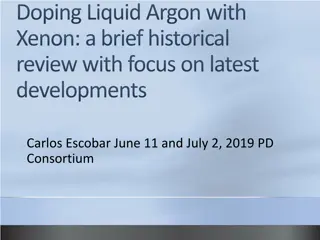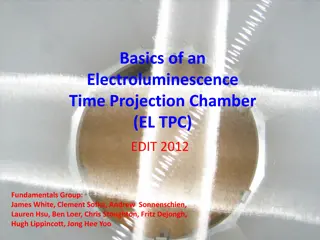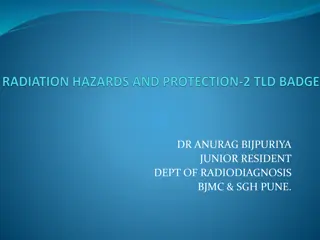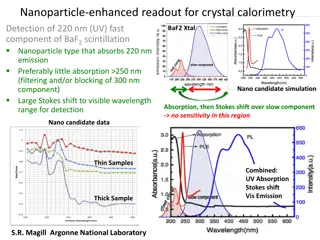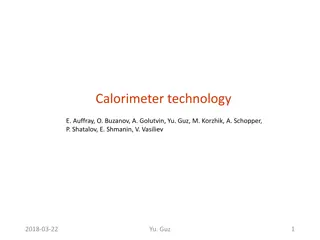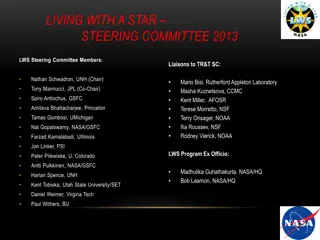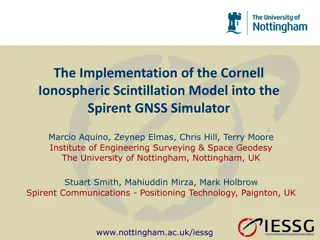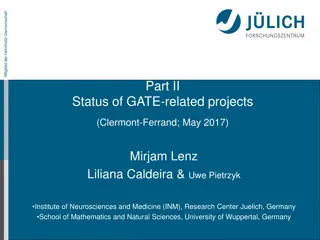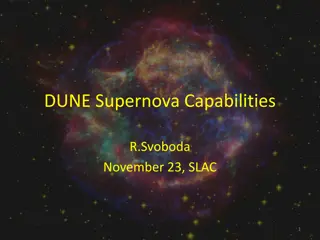Advanced Fission Experiments at University of Michigan
The University of Michigan, under the guidance of Dr. Sara A. Pozzi, conducts cutting-edge fission experiments leveraging organic scintillation detectors. These detectors offer advantages such as nanosecond-scale response times, energy proportionality, and scalability. The experiments focus on impro
0 views • 4 slides
Advancements in Doping Liquid Argon with Xenon: Historical Overview
Delve into the historical review and latest developments of doping liquid argon with xenon, aiming to shift light wavelengths for improved visibility in TPC volumes. Key questions address the effect on scintillation components, stability of xenon doping, and potential ice cluster formation. Early st
0 views • 27 slides
Understanding Electroluminescence Time Projection Chamber (EL TPC) Physics
Delve into the fundamentals of Electroluminescence Time Projection Chambers (EL TPCs) through concepts like electron drift, scintillation mechanisms in noble gases, and charge yield estimation. Explore the workings of EL TPC prototypes, such as ZEPLIN II/III and DarkSide, for applications like react
0 views • 23 slides
Radiation Detection and Dosimetry in Medical Imaging
Radiation detection and measurement are essential in radiology. Various instruments like ionization chambers, film badges, thermoluminescent dosimeters, and pocket dosimeters are used to monitor radiation exposure. Personnel dosimetry is crucial for tracking radiation doses over time to ensure safet
2 views • 31 slides
Nanoparticle-Enhanced Readout for Crystal Calorimetry: BaF2 Scintillation Detection
Nanoparticles with specific absorption and emission properties are explored to enhance the readout process for BaF2 crystal calorimetry, focusing on detecting the fast 220nm UV component. The goal is to achieve a large Stokes shift to the visible wavelength range for efficient detection, while minim
0 views • 7 slides
Advanced Calorimeter Technology for Particle Detection
Cutting-edge calorimeter technology for high-energy physics experiments is discussed in this content. The focus is on radiation-hard crystal scintillators and plastic scintillator-based Shashlik technology used in the present ECAL. Details about the requirements, materials, irradiation tests, and ad
0 views • 16 slides
Advancing the Living with a Star Program: Science Goals and Community Priorities
The Living with a Star (LWS) program, led by a dedicated steering committee, aims to provide yearly reports, set long-term visions, and address key science topics in solar and space physics. The community priorities include enabling discovery and addressing societal needs, emphasizing the importance
0 views • 11 slides
Implementation of Cornell Ionospheric Scintillation Model in Spirent GNSS Simulator
Researchers from the University of Nottingham and Spirent Communications collaborated to implement the Cornell Ionospheric Scintillation Model into the Spirent GNSS Simulator. The study focuses on the diffractive effects of ionospheric scintillation on GNSS signals, examining small-scale plasma irre
0 views • 24 slides
Status of GATE-related Projects at Helmholtz-Gemeinschaft
Helmholtz-Gemeinschaft's GATE-related projects involve research on PET-detector designs for BrainPET-insert, simulations of scintillation processes, and challenges with computing time for optical photon studies. Suggestions for improving efficiency are being discussed in the Steering Committee.
0 views • 11 slides
Advancements in Liquid Argon Time Projection Chamber Technology
Explore the capabilities of the DUNE project with a focus on the Far Detector conceptual design, operating principles of Single Phase LAr TPC, and advantages/disadvantages of liquid argon as a detection medium. The innovative technology allows for precise tracking at the sub-1mm level and facilitate
0 views • 36 slides

